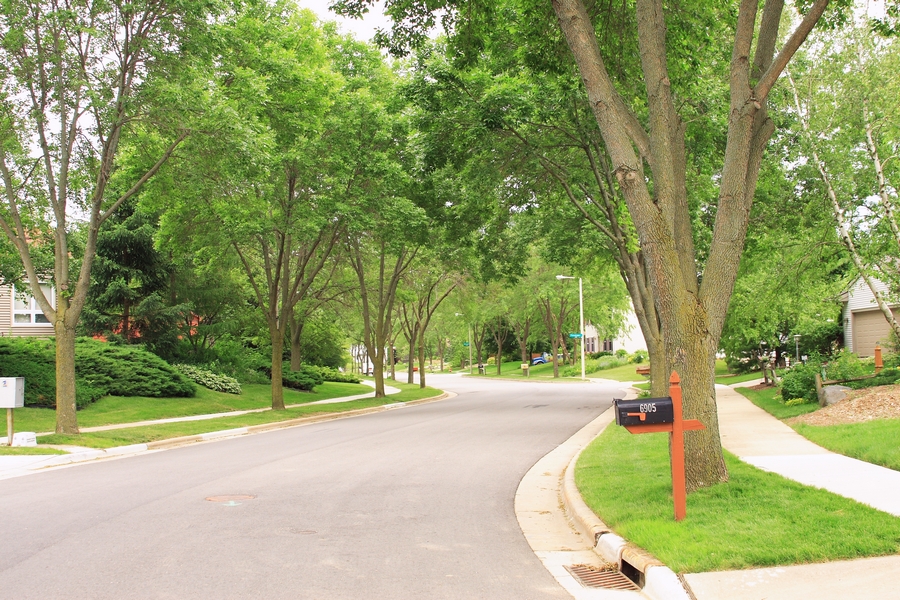 Are you responsible for tree care in your community? If so, please complete this survey to share the story of trees in your community. You can be an integral part of a 50-year data collection effort comparing tree activities across the country. Continue reading “Community Tree Care And Management Survey”
Are you responsible for tree care in your community? If so, please complete this survey to share the story of trees in your community. You can be an integral part of a 50-year data collection effort comparing tree activities across the country. Continue reading “Community Tree Care And Management Survey”
Data and analysis
Community Spotlight: West Allis’ Tree Inventory System
By Dan Buckler, DNR Urban Forest Assessment Specialist; Daniel.Buckler@wisconsin.gov or 608-445-4578
It was 2021 and the West Allis Forestry Division faced a crisis. For all intents and purposes, its tree inventory was no longer functional. The division had always been a program that kept and used a lot of data, but inefficiencies in the inventory process abounded, and now the software where the data was stored was essentially crashing. The status quo was clearly not working.
But as Winston Churchill apocryphally said, “Don’t let a crisis go to waste.”
Continue reading “Community Spotlight: West Allis’ Tree Inventory System”
Tree Inventory Subaccounts Available Within Wisconsin Community Tree Map
By Dan Buckler, DNR Urban Forest Assessment Specialist; Daniel.Buckler@wisconsin.gov or 608-445-4578
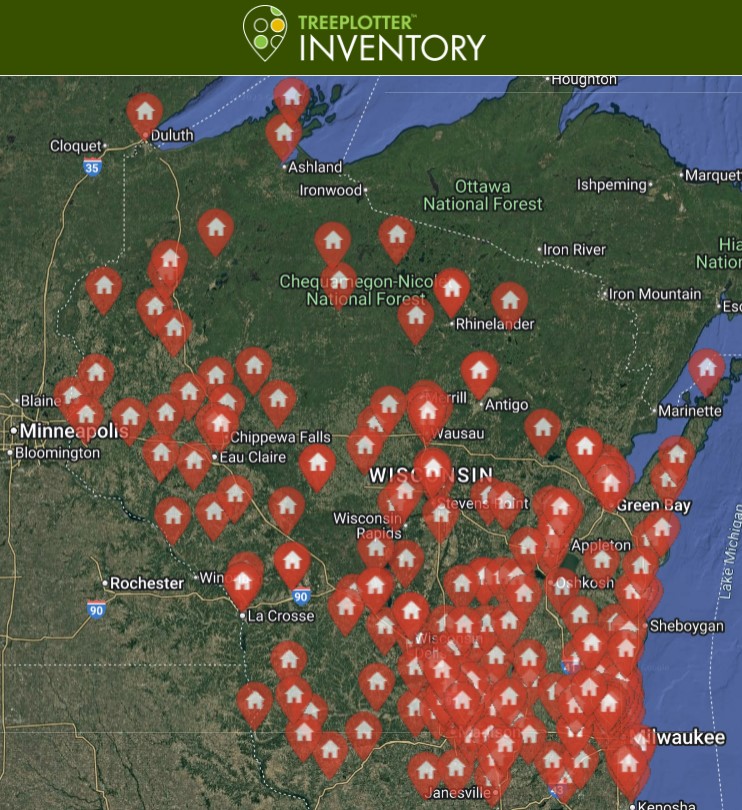 Do you have a tree inventory but have a hard time keeping it up to date? Or are you interested in inventorying trees from scratch?
Do you have a tree inventory but have a hard time keeping it up to date? Or are you interested in inventorying trees from scratch?
The Department of Natural Resources (DNR) has made a handful of “subaccounts” available for communities or organizations to edit data within the Wisconsin Community Tree Map at no cost to the community or organization.
Continue reading “Tree Inventory Subaccounts Available Within Wisconsin Community Tree Map”
Trees And Insurance Survey
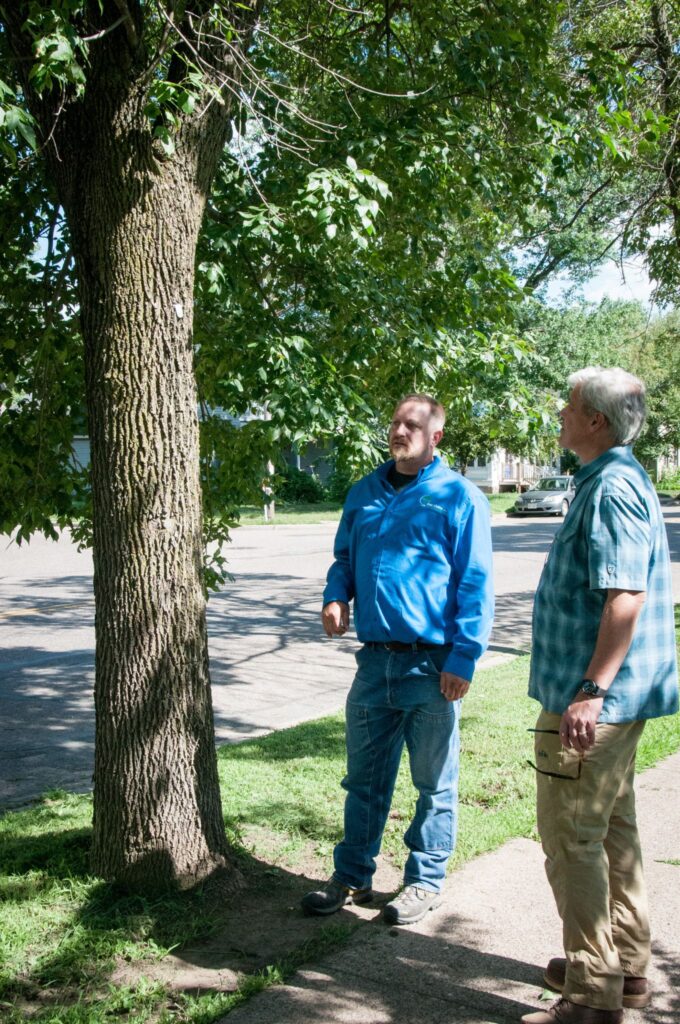 The Urban and Community Forestry Society (UCFS) Industry Trends committee – charged with monitoring the issues impacting your work – is seeking information on your experiences with insurance companies and urban tree canopy. There is growing evidence that insurance companies are directing the pruning or removal of trees, and the committee wants to fully understand the issue. Your responses to the survey below will help compile stories and evidence so that UCFS can work with industry partners and draft position statements. Continue reading “Trees And Insurance Survey”
The Urban and Community Forestry Society (UCFS) Industry Trends committee – charged with monitoring the issues impacting your work – is seeking information on your experiences with insurance companies and urban tree canopy. There is growing evidence that insurance companies are directing the pruning or removal of trees, and the committee wants to fully understand the issue. Your responses to the survey below will help compile stories and evidence so that UCFS can work with industry partners and draft position statements. Continue reading “Trees And Insurance Survey”
2025 Internal Audit Finds Sound Forestry And Room for Improvement
By Wisconsin DNR

A snowy trek through the woods at a Vilas County audit site. / Photo Credit: Wisconsin DNR
The annual internal audit of the Wisconsin Department of Natural Resources Managed Forest Law (MFL) Certified Group took place April 7-8 with visits to 40 certified MFL properties and completed timber harvests in north central Wisconsin – specifically, in Adams, Clark, Jackson, Lincoln, Marathon, Taylor, Oneida and Vilas counties.
An internal audit is required every year for both Forest Stewardship Council® (FSC) and American Tree Farm System® (ATFS) standards, under which the MFL Certified Group is dually certified. The audit reviews a selection of MFL properties where timber harvesting was completed within the previous three years.
Continue reading “2025 Internal Audit Finds Sound Forestry And Room for Improvement”
Please Submit Trees Planted This Spring!
By Dan Buckler, DNR Urban Forest Assessment Specialist; Daniel.Buckler@wisconsin.gov or 608-445-4578
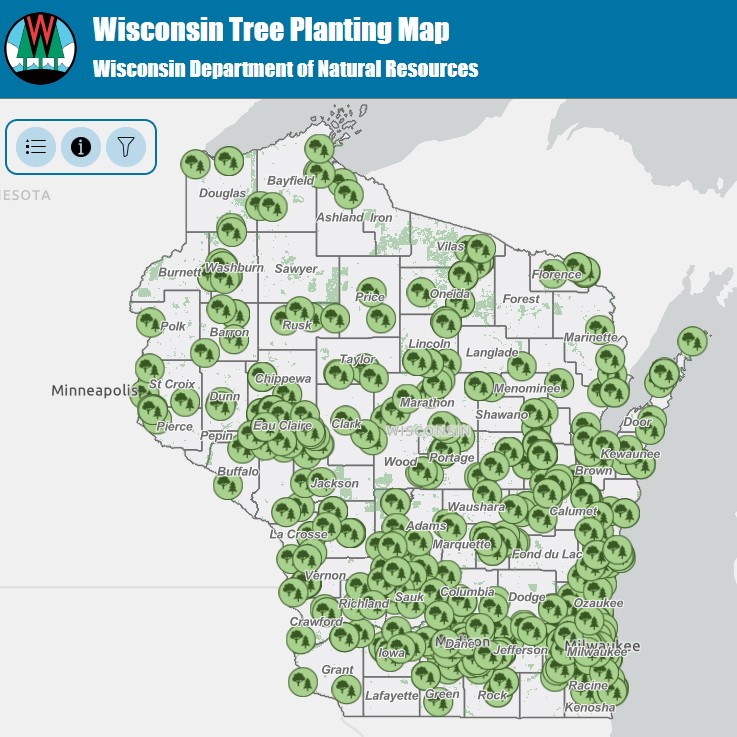 When your newly planted trees are getting comfortable in their new homes, you’ve pulled the splinters from your hands and you find yourself at a desk asking yourself, “What now?”, we have an answer for you.
When your newly planted trees are getting comfortable in their new homes, you’ve pulled the splinters from your hands and you find yourself at a desk asking yourself, “What now?”, we have an answer for you.
Please take a moment and record your trees in the Wisconsin Tree Planting Survey. Those submissions will then appear on the Tree Planting Map and be tallied toward the state’s pledge to the Trillion Trees Initiative. Governor Tony Evers signed the pledge to protect and restore Wisconsin’s rural and urban forests by planting 100 million trees in Wisconsin by 2030. Continue reading “Please Submit Trees Planted This Spring!”
Arbor Day Foundation Reporting Dashboard
Arbor Day Foundation USA Interactive Map
Do you know how many Tree Campus Healthcare facilities are in Wisconsin or how many trees were planted by Arbor Day Foundation partners in the state? Find this and other eye-opening information by visiting the new Arbor Day Reporting Dashboard. Scroll to select Wisconsin on the left side of the page to see state-specific data. Select a tab at the top to see specific information about the Tree City USA, Tree Campus or Tree Line programs. Continue reading “Arbor Day Foundation Reporting Dashboard”
Housing Wisconsin: Home Building Trends, Outlook
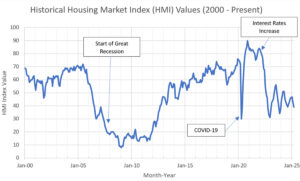
Housing Market Index (HMI) Survey, March 2025. Source: NAHB/Wells Fargo. / Graphic Credit: Brian Zweifel, Wisconsin DNR
By Brian Zweifel, DNR Forest Products Specialist, Dodgeville
Brian.Zweifel@wisconsin.gov
Variability and uncertainty seem like key words to describe many things right now, but the words apply especially to current housing markets.
The home construction and remodeling industry is a key driver of forest products markets and can be an important indicator of future demand. Softwood lumber and engineered wood products such as oriented strand board, plywood and laminated beams and joists are used in home construction. Hardwood lumber, however, is used to manufacture flooring, cabinets and other millwork items for interior applications.
Continue reading “Housing Wisconsin: Home Building Trends, Outlook”
A Closer Look At Red Pine In Wisconsin
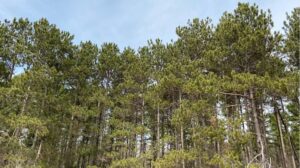
A stand of red pine trees towers over its Wisconsin stand. / Photo Credit: Wisconsin DNR
By Ryan Heiderman, DNR Forest Inventory Analyst
Ryan.Heiderman@wisconsin.gov
Of Wisconsin’s almost 17 million acres of forest land, the red pine forest type currently covers approximately 815,000 acres. Of those red pine acres, 80%, or 656,000 acres, are planted.
Overall, the acres of red pine have increased substantially since the cutover period of the early 1900s (Figure 1), particularly from planted red pine. In the 1939 report summarizing Wisconsin’s first periodic forest inventory, the authors give a dire warning stating that, with the exception of jack pine, the pine forests are almost gone, having been depleted and deforested in the decades prior.
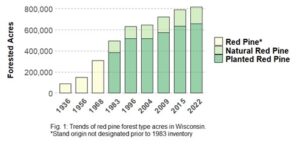
Chart showing trends of red pine forest type acres in Wisconsin. The asterisk indicates that stand origin was not designated prior to the 1983 inventory. / Graphic Credit: Ryan Heiderman, Wisconsin DNR
This early inventory indicated much of the deforested sandy pine forest had become occupied by aspen, paper birch and scrub oak. They went on to say while natural regeneration might be expected eventually, indications were that it would be slow, and planting seemed to be the only recourse if early reforestation was to be accomplished.
Reporting on the next periodic inventory in 1956, the authors highlighted that red pine acres were ‘coming back’ and white pine acres fading. They reported that much of the tree planting that had been done since the previous inventory was mostly red pine. Echoing the advice from the earlier inventory report, the authors again stated the importance of forest planting – saying reforestation could increase the acreage of productive forest land, but the planting job was a big one. At the time, they reported some 148,000 acres of the red pine forest type. They reported that over half (53%) of these red pine acres were on public lands. Today, more than 60% of red pine acres are in privately-owned forests.
Impact Of Home Building On Wood Products Sector
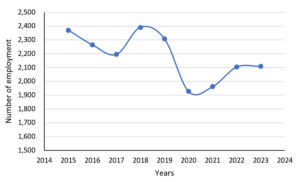
Figure 1. Number of full-and part-time sawmill employment in Wisconsin, 2015-2023. Data Source: IMPLAN. / Graphic Credit: Ram Dahal, Wisconsin DNR
By Ram Dahal, DNR Forest Economist, Madison
Ram.Dahal@wisconsin.gov
Residential home construction heavily depends on wood products like lumber. When housing starts increase, the demand for softwood and hardwood lumber and engineered wood products typically rises, and vice versa.
The home building market experienced a variety of challenges in recent years due to stay-at-home orders during the COVID-19 pandemic. In the second quarter of 2020, the US experienced a reduction of more than 25% in new privately owned housing starts compared to the previous quarter. Almost all regions experienced similar downfall (Figure 1).
Continue reading “Impact Of Home Building On Wood Products Sector”
